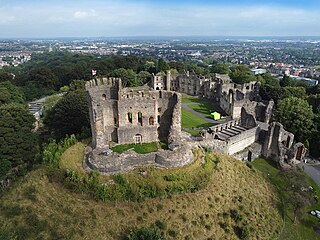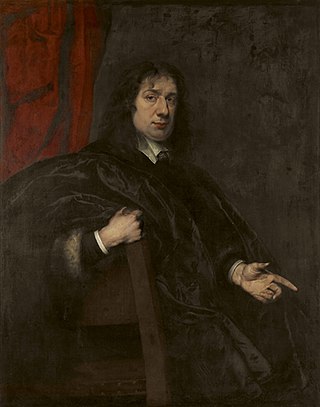Related Research Articles

Dudley Castle is a ruined fortification in the town of Dudley, West Midlands, England. Originally a wooden motte and bailey castle built soon after the Norman Conquest, it was rebuilt as a stone fortification during the twelfth century but subsequently demolished on the orders of Henry II of England. Rebuilding of the castle took place from the second half of the thirteenth century and culminated in the construction of a range of buildings within the fortifications by John Dudley. The fortifications were slighted by order of the Parliament of England during the English Civil War and the residential buildings destroyed by fire in 1750. In the nineteenth and early twentieth century the site was used for fêtes and pageants. Today Dudley Zoo is located on its grounds.

The Stour(, rhymes with "flour") is a river flowing through the counties of Worcestershire, the West Midlands and Staffordshire in the West Midlands region of England. The Stour is a major tributary of the River Severn, and it is about 25 miles (40 km) in length. It has played a considerable part in the economic history of the region.

Baron Dudley is a title in the Peerage of England. It was created circa 1440 for John Sutton, a soldier who served as Lord Lieutenant of Ireland. The title descended in the Sutton family until the 17th century when Frances Sutton, the heir apparent to the title, married Humble Ward who was granted the title Baron Ward in 1644. Their heirs inherited both titles until 1740 when the differing rules of inheritance meant that the Barony of Dudley descended on Ferdinando Dudley Lea, who became the 11th Baron whilst the Barony of Ward went to John Ward, who later became 1st Viscount Dudley and Ward. On Ferdinando's death in 1757, the title fell into abeyance. The title was revived in 1916.

Edward Sutton, 5th Baron Dudley was an English peer, politician and landowner who briefly sat in the House of Commons. Through his intemperate behaviour he won widespread notoriety, completed the financial ruin of his family, and was the last of his name to bear the title.

Ashwood is a small area of Staffordshire, England.
Kinver is a large village in the District of South Staffordshire in Staffordshire, England. It is in the far south-west of the county, at the end of the narrow finger of land surrounded by the counties of Shropshire, Worcestershire and the West Midlands. The nearest towns are Stourbridge, West Midlands, Kidderminster in Worcestershire and Bridgnorth, Shropshire. The Staffordshire and Worcestershire Canal passes through, running close to the course of the meandering River Stour. According to the 2011 census Kinver ward had a population of 7,225.
Philip Foley was the youngest of the three surviving sons of the British ironmaster Thomas Foley. His father transferred all his ironworks in the Midlands to him in 1668 and 1669 for £60,000. He also settled an estate at Prestwood near Stourbridge on him on his marriage, to which Philip added the manor of Kinver.
Stourton is a hamlet in Staffordshire, England a few miles to the northwest of Stourbridge. There is a fair amount of dispute over the pronunciation, being pronounced 'stower-ton', 'stir-ton' or 'store-ton' by different people from the area. The nearest sizeable villages are Wollaston and Kinver, the nearest hamlets are Prestwood and Dunsley. It lies on the River Stour. The Staffordshire and Worcestershire Canal and Stourbridge Canal meet at Stourton Junction, which places Stourton on the Stourport Ring, a navigable waterway popular with narrowboat holidaymakers.
Swindon is a village and civil parish located in the West Midlands. The nearest major town is Dudley, approximately five miles eastwards. It stands halfway between the small town of Kingswinford and village of Wombourne.
John Hodgetts Hodgetts-Foley, born John Hodgetts Foley, of Prestwood House in Staffordshire was a British MP.

Edward Thomas Foley, of Stoke Edith, Herefordshire, was an English Tory politician.

Edward Foley was the second son of Thomas, 1st Lord Foley.
Henry John Wentworth Hodgetts-Foley of Prestwood House, then in Kingswinford parish was a British MP.

Sir Edward Littleton was a Staffordshire landowner, politician and rebel from the extended Littleton/Lyttelton family. A supporter of Robert Devereux, 2nd Earl of Essex, he was the victim of a notorious electoral fraud in 1597 and a participant in the Essex Rebellion, although he escaped with his life. In the reign of James I he was elected a member of the parliament of England.
Sir Thomas Whorwood was a Staffordshire landowner, Member of the English Parliament and High Sheriff of Staffordshire. He became notorious for his involvement in election fraud.
Dunsley is a hamlet in Kinver, Staffordshire, England.
Kinver Forest was a Royal Forest, mainly in Staffordshire.
John Bradley & Co was a company established in 1800 by John Bradley at Stourbridge in the West Midlands area of England. The company developed into a large industrial concern with furnaces, ironworks and mines. Under James Foster, John Bradley's half brother, it was instrumental in bringing the first commercial steam locomotive into the Midlands area in 1829. The firm stayed under family control until the early years of the 20th century when first the mining (1913) and then the ironworks (1919) were sold off. Part of the business continued to trade under the name John Bradley & Co. (Stourbridge) Ltd until after the Second World War.

The Lyttelton family is a British aristocratic family. Over time, several members of the Lyttelton family were made knights, baronets and peers. Hereditary titles held by the Lyttelton family include the viscountcies of Cobham and Chandos, as well as the Lyttelton barony and Lyttelton baronetcy. Several other members of the family have also risen to prominence, particularly in the field of cricket.
Sir Ferdinando Sutton (1588-1621) was an English aristocrat.
References
- ↑ D. Hooke, The Landscape of Anglo-Saxon Staffordshire: the charter evidence (Keele University 1983: Department of Adult Education), 29 66 70-2.
- ↑ Domesday Book, f.247d.
- ↑ This is based on various documents listed in Calendars of Patent Rolls, Calendars of Inquisitions Post Mortem, and so on.
- 1 2 This is partly based on estate title deeds, in the Foley collection at Herefordshire Record Office.
- ↑ The descent from the 1670s is much the same as the manor of Kinver: Victoria County History: Staffordshire, XX, 130.